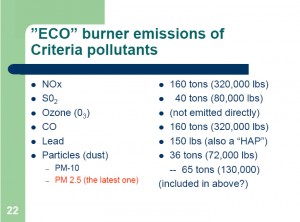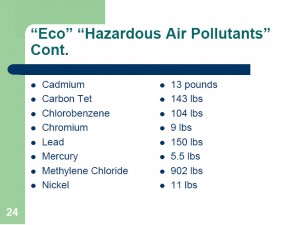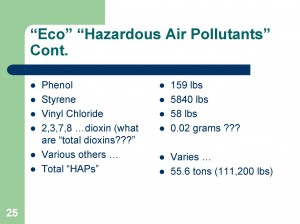
Clark County is headed down the wrong path… burning “biomass” in the wrong-headed notion that it’s G-R-E-E-N, with little regard for the toxic emissions that will spew from this plant, and it’s “carbon neutral” NOT! Recently, somebody from Clark County was searching for “Rockford MN biomass” and ended up on my site, which is a good thing, because then at least they might get some reality about what’s proposed.
They’re looking at a district heating project similar to the Midtown Burner (Midtown Eco-Crapper) proposed for Phillips, in Minneapolis, and thankfully it was run out of town, developers then tried for the City of Rockford, MN, and it was run out of town, and then the township of Rockford, and it’s history there too!
As with the Midtown burner, this Vancouver biomass plant is proposed for the middle of Vancouver — the worst place possible for projects like this that will spew emissions!
Spew emissions? HUH? Well DUH, and here’s Alan Muller’s presentation on the Midtown burner:
Saying NO! to permits for Midtown Eco-Energy
What do the Clark County biomass project promoters say?
But Candee Hatch, an air quality consultant with Lake Oswego-based Bridgewater Group who was a consultant on the study, said opposition to such a facility is likely colored by what older, dirtier biomass plants looked like.
“Technology-wise, these facilities are not like they used to be 20 years ago, and a lot of the perception about what wood-burning is comes from what we used to do,” she said. “Those facilities don’t look like that anymore.”
Oh, please… show us your emissions, Candee!!!
Here are some specifics about annual emissions from a recent similar biomass district heat project:




… and the Clark Count proposal? Here’s some info:
Clark County District Heating (biomass project) page
Here’s the fuel study, where they claim to have enough fuel:
Fuel Study – January 2011
What’s missing is specifics on emissions — come on, folks, out with it!!!
And an article from The Oregonian:
Clark County commissioners give downtown Vancouver biomass plant a green light
Clark County will move ahead with its plan for a wood-burning heating and cooling plant in downtown Vancouver by seeking a private-sector partner and land-use permits from the city.
County staff looked to the Clark County commissioners to make a call on the plan Wednesday after presenting the latest study of its feasibility. With the commissioners’ green light, the county will put out a request for proposals from companies interested in operating the plant as soon as Friday.
The feasibility study, conducted by Vancouver biomass consulting firm LD Jellison, concluded biomass would be cheaper to operate than the county’s existing natural gas-powered system and that, unlike natural gas, it would be carbon neutral.
“We believe this project meets sustainability objectives to a T,” county General Services Director Mark McCauley said.
That might be a point of debate. Burning wood releases carbon dioxide just like natural gas, but biomass supporters say the carbon would be released whether that wood was burned or rotting in the woods. And in the case of the county’s fuel, the timber scraps would likely have been burned in a field.
And regardless, state law recognizes biomass as carbon neutral, meaning it fulfills sustainability mandates and qualifies for renewable energy incentives.
The plant would put out emissions higher than fossil fuel – twice as much carbon dioxide and three times as much carbon monoxide. But biomass is a renewable energy source, and McCauley said those emissions would meet all clean air standards.
“It’s not a goal, it’s a requirement,” McCauley said. “If we couldn’t meet those standards, a project like this couldn’t be permitted.”
Winning over a private partner will likely be easier than convincing a skeptical Vancouver City Council and people who live nearby.
McCauley said about 10 companies had expressed interest, including some unsolicited inquiries. The county worked with the German electrical engineering company Siemens AG, the French Schneider Electric and Canadian biomass company Nexterra to help develop and evaluate its plan for a public-private partnership.
But members of the City Council have expressed skepticism or outright opposition to the project. The council would have to adjust its zoning code to allow the biomass plant.
And at Wednesday’s meeting, handful of residents from the downtown Esther Short neighborhood attended the meeting and, when offered a chance to speak or ask questions, expressed some skepticism over the project.
But Candee Hatch, an air quality consultant with Lake Oswego-based Bridgewater Group who was a consultant on the study, said opposition to such a facility is likely colored by what older, dirtier biomass plants looked like.
“Technology-wise, these facilities are not like they used to be 20 years ago, and a lot of the perception about what wood-burning is comes from what we used to do,” she said. “Those facilities don’t look like that anymore.”
And Commissioner Steve Stuart noted some of the permitted uses for the land – which is next to, among other things, the county jail – could include car lots and fuel stations.
“I would certainly rather have this facility than another parking garage or a used car lot,” he said.
The county’s proposed biomass plant, located at 13th and Harney streets on the county’s campus, would burn timber scraps to generate hot water and steam. The hot water would be piped to five county buildings to provide heat, and the steam would power the cooling system and generate electricity the private partner operating the plant could sell.
The company operating the plant would pay the estimated $25 million cost of construction and converting the county’s heating system, and it would lease the plant from the county. The county would buy the hot water and steam needed to heat and cool its buildings.





Leave a Reply